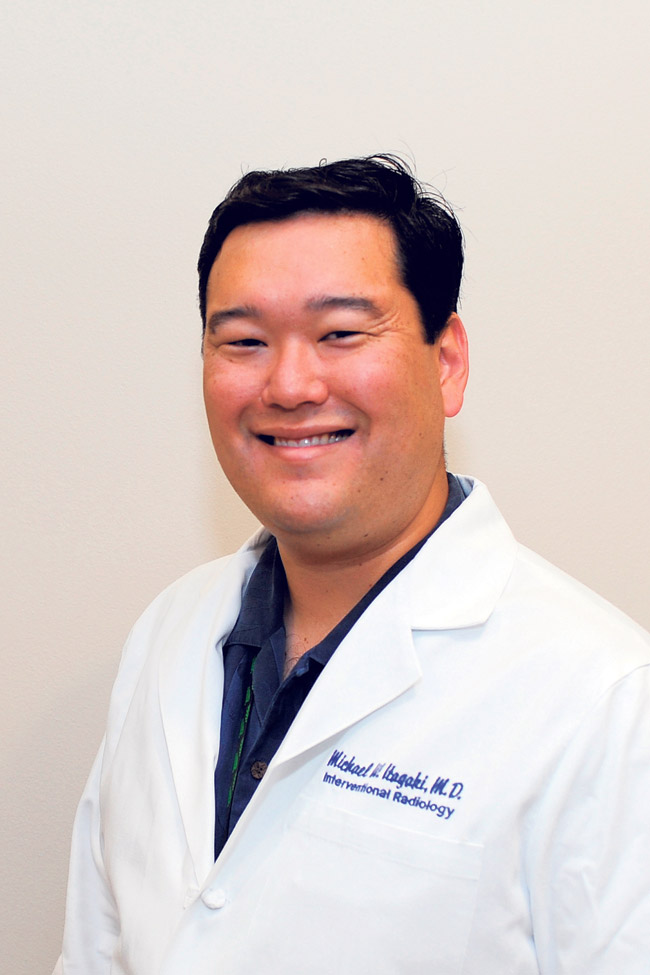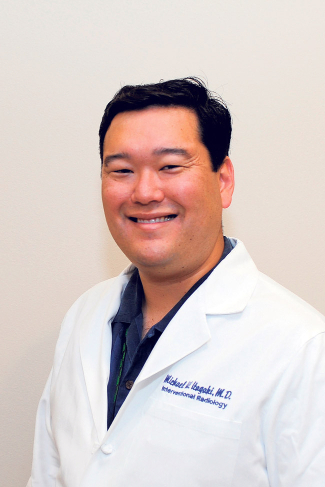Tiny Catheter Treats Liver Cancer
Dr. Michael Itagaki
Interventional radiologist at The Queen’s Medical Center
Where did you receive your schooling and training?
I went to Punahou for high school, Harvard for undergraduate, and did my graduate studies at the University of Illinois. I did my residency in general radiology at UCLA and my fellowship in interventional radiology at the University of Washington in Seattle.
How long have you been practicing?
I’ve been at Queen’s for more than a year.
What is an interventional radiologist?
Radiologists are specialists in imaging: CT scans, MRI, ultrasounds, X-rays. An interventional radiologist is a doctor who specializes in image-guided procedures. The hallmark of all of our procedures is that they are minimally invasive. We use ultrasound, X-ray, CT and MRI so we don’t have to make a big incision to see what we’re doing. Most of the procedures are done through a tiny needle puncture.
Can you give an overview of your new liver cancer treatment?
We’re now offering at Queen’s a treatment for liver cancer where we take a very small catheter and under X-ray guidance navigate it to the artery that goes to a liver tumor. From that position, we inject very fine particles. The particles emit radiation for a very short distance. It’s lethal to the tumor, but the radiation only goes about 2.5 millimeters and then it stops. The tumor gets a high dose of radiation, but the radiation does not escape and go outside the patient or to the other tissues of the patient. It’s a way to treat the tumor with radiation from the inside out.
Typically the procedure is done on an outpatient basis, so the patient gets the procedure and we monitor them for a few hours afterwards to make sure they’re feeling fine, and then they go home. Most patients feel nothing during the treatment.
Is there an ideal candidate?
The procedure is used for cancer that arises from the liver itself, called primary liver cancer. But it’s also used for cancer that started elsewhere and spread to the liver, including colon or rectal cancer, some pancreatic cancers, breast cancer and melanoma. Ongoing research is currently investigating treatment of other cancer types that have spread to the liver. Often these patients who are eligible have tried and failed chemotherapy, and they are not eligible for surgery because of their age or because the disease has spread too much, so they have no options. Chemotherapy – when it stops working, you’re out of luck.
Now we can offer this new treatment that is tolerated very well and causes the tumors to stop growing or to shrink, and it buys months if not years of high quality life for the patients.
How long does the radioactive substance keep working?
It emits radiation in the tumor for one to two weeks, but the effects of the radiation – because of the damage to the tissue – keep working for months. Typically, the tumors will continue to shrink even after the actual physical emission of radiation has stopped. We follow the patients with CT scans or MRIs, and if they need repeat treatment we can do that as well, so it’s something that can be done multiple times.
Do you generally need follow-up treatment?
It’s on a case-by-case basis. Usually it works pretty well the first time.
Can the treatment be used on other organs?
The research has primarily focused on the liver because the liver tolerates injection of materials into it very well. There is ongoing research to study it for other organ systems, but that’s still in an investigational phase.
Technically, the kinds of cancer that we’re best at treating are hepatocellular carcinoma, which arises from the liver, colon or rectal cancer that spreads to the liver, or a kind of tumor called neuroendocrine cancer, which often comes from the pancreas and spreads to the liver. That’s the kind of cancer Steve Jobs had, and he got a liver transplant because of it. Liver transplants play a role in patients who have these kinds of cancers, but very few people can qualify for them.
Hawaii has the highest incidence of hepatocellular carcinoma in the nation, because liver cancer has a tendency to affect Asian populations more, and we have a high Asian population relative to most states.
There’s a kind of hepatitis virus that is more common in Asia than in Europe or the United States, which contributes to that statistic.
Are there any side effects similar to chemotherapy?
There are some mild side effects that happen in a minority of the cases. Sometimes people feel mild pain for eight to 12 hours afterwards, but that is easily treated with oral anti-pain medications, and sometimes people feel nausea for about eight to 12 hours, but that’s in a minority of patients, and compared to the alternative treatments it’s very mild. Most people don’t feel anything.
Are you the only one on Oahu who offers this treatment?
There is one other physician at Queen’s who also is certified. You need to be certified. The treatment has been available on the Mainland primarily at large academic medical centers for about 10 years, but it hasn’t been available in Hawaii before this past winter, when I did the first treatment. It’s a great treatment for patients who have no other options. Previously, there was nothing available to them in Hawaii, but now there is something. We give patients quality of life, and we can extend their lives without making them feel very ill in the process.







